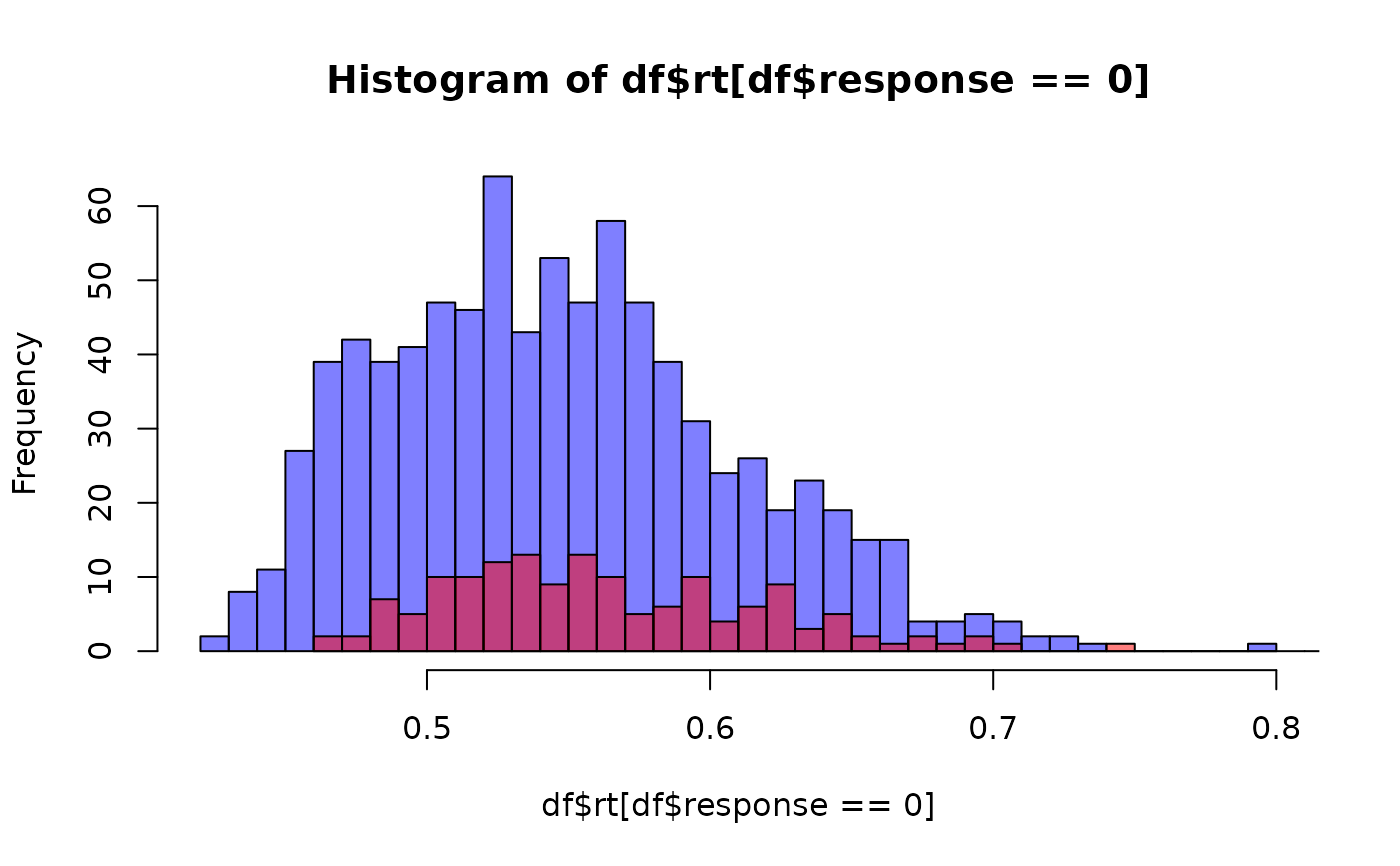Simulates random draws (reaction times and choices) from a two-choice Linear Ballistic Accumulator (LBA) model.
In this parametrization, each accumulator has its own independent drift rate distribution:
Accumulator 0 has drift drawn from N(driftzero, sigmazero^2).
Accumulator 1 has drift drawn from N(driftone, sigmaone^2).
For each trial, drift rates are sampled on an individual basis until at least one of the two is positive. The starting point for each accumulator is sampled uniformly from (0, sigmabias). The decision threshold is defined as sigmabias + bs. The decision time for an accumulator is calculated as (b - start)/drift, and if its drift is not positive, its decision time is set to Inf. The winning accumulator (the one whose decision time is minimal) determines the response, and the final reaction time is the sum of its decision time and a fixed non-decision time (ndt).
Usage
rlba(
n,
driftzero = 3,
driftone = 3,
sigmazero = 1,
sigmaone = 1,
sigmabias = 0.5,
bs = 0.5,
ndt = 0.3,
max_iter = 100
)
dlba(
x,
driftzero = 3,
driftone = 3,
sigmazero = 1,
sigmaone = 1,
sigmabias = 0.5,
bs = 0.5,
ndt = 0.3,
response,
log = FALSE
)
lba_lpdf_expose()
lba_stanvars()
lba(
link_mu = "identity",
link_driftone = "identity",
link_sigmazero = "softplus",
link_sigmaone = "softplus",
link_sigmabias = "softplus",
link_bs = "softplus",
link_tau = "logit",
link_minrt = "identity"
)
log_lik_lba(i, prep)
posterior_predict_lba(i, prep, ...)
posterior_epred_lba(prep)Arguments
- n
Number of simulated trials. Must be a positive integer.
- driftzero
Mean drift rate for the first accumulator (accumulator 0). Range: (-Inf, Inf).
- driftone
Mean drift rate for the second accumulator (accumulator 1). Range: (-Inf, Inf).
- sigmazero
Standard deviation of the drift rate for the first accumulator. Must be positive. Range: (0, Inf).
- sigmaone
Standard deviation of the drift rate for the second accumulator. Must be positive. Range: (0, Inf).
- sigmabias
Maximum starting point for the uniform distribution of starting evidence (0, sigmabias). Must be positive. Range: (0, Inf). Default: 0.5.
- bs
Additional amount beyond
sigmabiasto set the decision threshold (b = sigmabias + bs). Must be positive. Range: (0, Inf). Default: 0.5.- ndt
Non-decision time, representing processes such as encoding and motor response. Must be non-negative. Range: [0, Inf). Default: 0.3.
- max_iter
Maximum iterations allowed (per trial) for resampling drift rates if both are non-positive. Default: 100.
- x
The observed reaction time (RT). Must be greater than
ndt.- response
The decision indicator (0 or 1). 0 for choice 0, 1 for choice 1.
- log
Logical; if TRUE, returns the log-density. Default: FALSE.
- link_mu, link_driftone, link_sigmazero, link_sigmaone, link_sigmabias, link_bs, link_tau, link_minrt
Link functions for the parameters.
- i, prep
For brms' functions to run: index of the observation and a
brmspreparation object.- ...
Additional arguments.
Details
Psychological Interpretation:
Drift Rate (
driftzero,driftone): Reflects the rate at which evidence accumulates for each choice. Higher drift rates indicate faster evidence accumulation and a higher likelihood of selecting the corresponding choice. Differences in drift rates between accumulators can represent differences in preference, difficulty, or bias between the two options.Drift Rate Variability (
sigmazero,sigmaone): Captures trial-to-trial variability in the evidence accumulation process. Higher variability indicates less consistent evidence accumulation, leading to greater variability in reaction times and choices.Start Point Variability (
sigmabias): Represents the range of initial evidence levels for each accumulator. Larger values ofsigmabiasintroduce more variability in reaction times, as the starting point can vary more widely between trials.Threshold (
b = sigmabias + bs): Boundary separation (bs). Represents the amount of evidence required to make a decision. Higher thresholds lead to longer reaction times but more accurate decisions, as more evidence is required before a choice is made.Non-Decision Time (
ndt): Accounts for processes unrelated to evidence accumulation, such as sensory encoding and motor response. This parameter shifts all reaction times by a constant amount.
References
Brown, S. D., & Heathcote, A. (2008). The simplest complete model of choice response time: Linear ballistic accumulation. Cognitive Psychology, 57(3), 153-178. doi:10.1016/j.cogpsych.2007.12.002
Examples
df <- rlba(n = 1000, driftzero = 3, driftone = 2,
sigmazero = 0.5, sigmaone = 0.5,
sigmabias = 0.5, bs = 0.5, ndt = 0.3)
hist(df$rt[df$response == 0], breaks = 50, col = rgb(0,0,1,0.5))
hist(df$rt[df$response == 1], breaks = 50, col = rgb(1,0,0,0.5), add = TRUE)
 # You can expose the lpdf function as follows:
# lba_lpdf <- lba_lpdf_expose()
# lba_lpdf(...)
# You can expose the lpdf function as follows:
# lba_lpdf <- lba_lpdf_expose()
# lba_lpdf(...)